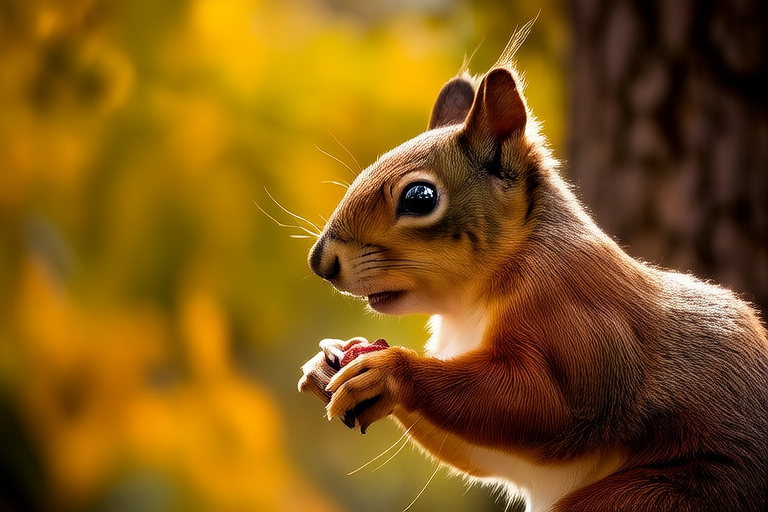
Squirrels: More Than Just Cute Creatures in the Park
When you think of squirrels, images of bushy-tailed creatures scurrying up trees or darting across park lawns likely come to mind. While these rodents are indeed charming to watch, they play a much more significant role in our ecosystems than their reputation as mere backyard nuisances might suggest. From their complex social structures to their vital contributions to forest regeneration, squirrels are fascinating subjects of study that deserve a closer look.
The Role of Squirrels in Ecosystems
One of the most important roles that squirrels play is seed dispersal. By burying seeds throughout their territories, they inadvertently aid in the growth of new plants. This process, known as scatter hoarding, helps maintain the diversity of plant life in forests. For instance, studies have shown that grey squirrels (Sciurus carolinensis) can cache thousands of acorns each year. Many of these seeds remain buried and eventually sprout into oak trees, contributing to the forest’s future structure.
In addition to their role as seed dispersers, squirrels also serve as prey for numerous predators, including birds of prey, foxes, and even large snakes. This makes them integral components of food webs, helping to regulate populations of both predator and prey species. Their presence can influence the behavior of other animals, creating intricate ecological relationships.
Beyond Gathering Nuts: Unique Behaviors
While many people associate squirrels with their affinity for nuts, their behavioral repertoire extends far beyond this stereotype. For example, some species exhibit sophisticated problem-solving skills. Researchers at the University of California, Berkeley, discovered that ground squirrels (Spermophilus beecheyi) can learn to open complex locks within just a few attempts. This ability showcases their adaptability and intelligence, which are crucial for survival in changing environments.
Another intriguing aspect of squirrel behavior is their communication methods. These animals use a variety of vocalizations and body language to convey messages about danger, mating opportunities, and territorial boundaries. Scientists have identified over 20 distinct calls used by eastern gray squirrels alone. Some of these sounds serve as alarm signals, warning others of approaching predators like hawks or domestic cats.
Adaptations for Survival
To thrive in diverse habitats ranging from dense forests to bustling cities, squirrels have evolved several remarkable adaptations. Their sharp claws enable them to climb trees effortlessly, while their flexible bodies allow for quick turns and jumps. Additionally, squirrels possess excellent vision, hearing, and sense of smell, all of which help them detect threats and locate food sources efficiently.
One particularly interesting adaptation is the way squirrels handle cold weather. During winter months, when food becomes scarce, many squirrel species enter a state of torpor – a temporary drop in body temperature and metabolic rate. This allows them to conserve energy until conditions improve. However, unlike true hibernation seen in bears or bats, torpor episodes last only a day or two before the animal returns to normal activity.
Interactions with Urban Environments
The increasing urbanization of many parts of the world has led to unexpected changes in how squirrels live and interact with humans. In cities, squirrels often find abundant sources of food such as bird feeders, garbage bins, and gardens. As a result, they have adapted their diets accordingly, sometimes relying heavily on human-provided sustenance.
This shift towards urban living presents both challenges and opportunities for squirrels. On one hand, it exposes them to new dangers like traffic accidents and conflicts with pets. On the other hand, urban areas offer protection from natural predators due to reduced tree cover and increased human presence. Moreover, city parks provide ideal nesting sites and ample space for foraging.
The Significance of Ecological Balance
The importance of maintaining ecological balance cannot be overstated. Squirrels contribute significantly to this equilibrium through their activities. By dispersing seeds and controlling insect populations via predation, they help ensure healthy ecosystems that support countless other species. Without squirrels’ efforts, forests might become less diverse and resilient against disturbances like climate change or deforestation.
Furthermore, observing squirrel behavior offers valuable insights into broader ecological principles. For instance, studying how different squirrel species respond to environmental stressors provides clues about potential impacts on wildlife communities under future scenarios. Understanding these dynamics is essential for developing effective conservation strategies aimed at preserving biodiversity.
Anecdotes and Scientific Insights
Consider the story of Professor Lucy Aplin from Oxford University who conducted an experiment involving European red squirrels (Sciurus vulgaris). She placed artificial nests filled with peanut butter inside oak trees along with real nests containing hazelnuts. To her surprise, the squirrels showed strong preferences based on taste rather than nutritional value – choosing the peanut butter nests despite knowing they contained no edible seeds. This finding demonstrates the complexity of squirrel decision-making processes and highlights the importance of considering sensory cues when designing conservation programs.
Another fascinating discovery comes from researchers at Cornell University who investigated scent marking behaviors among eastern gray squirrels. They found that males mark territory boundaries more frequently during breeding season compared to females. This pattern suggests that scent marking serves dual purposes: attracting mates while simultaneously deterring rivals. Such observations deepen our understanding of reproductive strategies employed by these small mammals.
Conclusion
Squirrels may appear simple at first glance, but upon closer examination, they reveal themselves as highly intelligent and adaptable creatures playing critical roles within their ecosystems. Whether through their contributions to seed dispersal, problem-solving abilities, or interactions with urban environments, these ubiquitous animals continue to surprise us with their complexity and importance.
As we strive to protect natural habitats and promote sustainable development, recognizing the value of even seemingly common species like squirrels becomes increasingly important. By appreciating their unique characteristics and behaviors, we gain a deeper appreciation for the interconnectedness of life on Earth.




